I didn’t go up into the Wasatch Mountains yesterday thinking I would find a rare bird but that is precisely what happened after I spotted a beautiful male Baltimore Oriole fly into a serviceberry bush in Morgan County.
I had driven around looking for birds but earlier in the morning the wind had been blowing in the canyon and many of the smaller birds seemed like they were hunkered down, I wasn’t seeing or hearing the birds I normally do so as I headed up the canyon I decided it might just be an early day. I’d gotten some nice Great Blue Heron photos early on and I was happy with them.
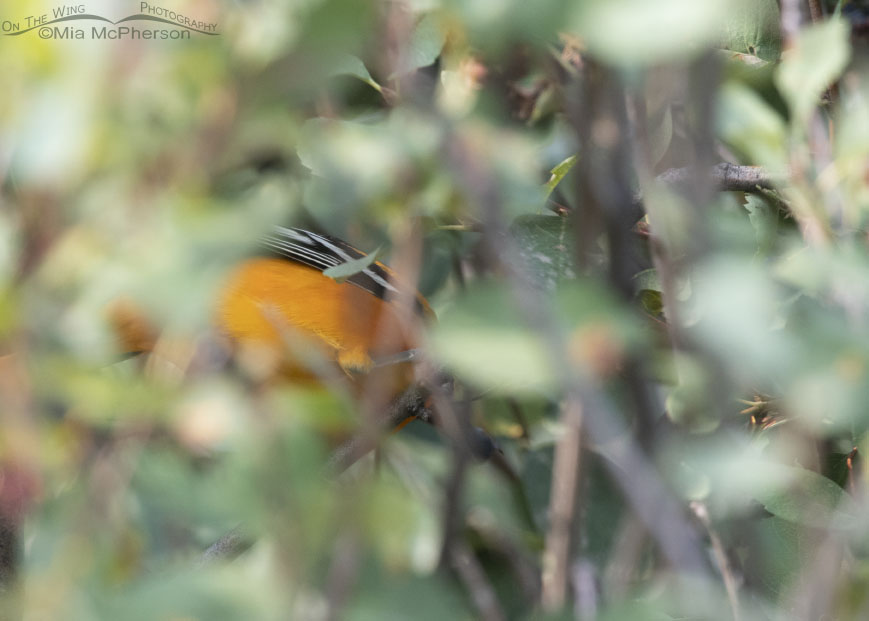 First view of rare male Baltimore Oriole in Utah
First view of rare male Baltimore Oriole in Utah
When I am driving and looking for birds I take my time, drive slowly, keep my eyes out for birds, large and small, and I listen for calls.
I stopped a few times to look for birds in areas where I had seen a lot of activity in the past and when I didn’t see or hear anything I moved on. Not long before I would have gotten onto the hard top road to head home I saw lots of little birds flying back and forth across the road into the shrubbery that lined both sides of the dirt road.
I pulled over across from a Utah Serviceberry and Chokecherry that had grown together and waited. I knew it might take some time for the birds to come back and they did. First a Black-capped Chickadee then a hungry Orange-crowned Warbler came in. A male Downy Woodpecker made an appearance not far from a handsome male Lazuli Bunting. Sparrows who moved so quickly I didn’t get clear enough views to ID them, a Green-tailed Towhee showed up and poked at a ripe berry before flying away. A Blue-gray Gnatcatcher call clued me in to its presence high in a tree on the hillside, a young American Robin perched in the chokecherry and a Dusky Flycatcher flew in and entertained me by catching a moth and a caterpillar so close to me that I had trouble fitting it into my view finder.
When the bird activity slowed down I thought about packing it in and heading home. I was on the verge of doing just that when I saw a robin-sized bird fly into the serviceberry, it was flame orange, black and I saw flashes of white. I knew it wasn’t an American Robin just from the shape and coloration, I also knew it wasn’t a Bullock’s Oriole because it was the wrong color.
So I looked through my lens and tried to find the bird in the foliage of the serviceberry and when I saw a bright orange spot in the leaves I tried focusing on it. The photo above is what I could see. It was enough for me to make a tentative ID of Baltimore Oriole which I knew wasn’t common here in Utah.
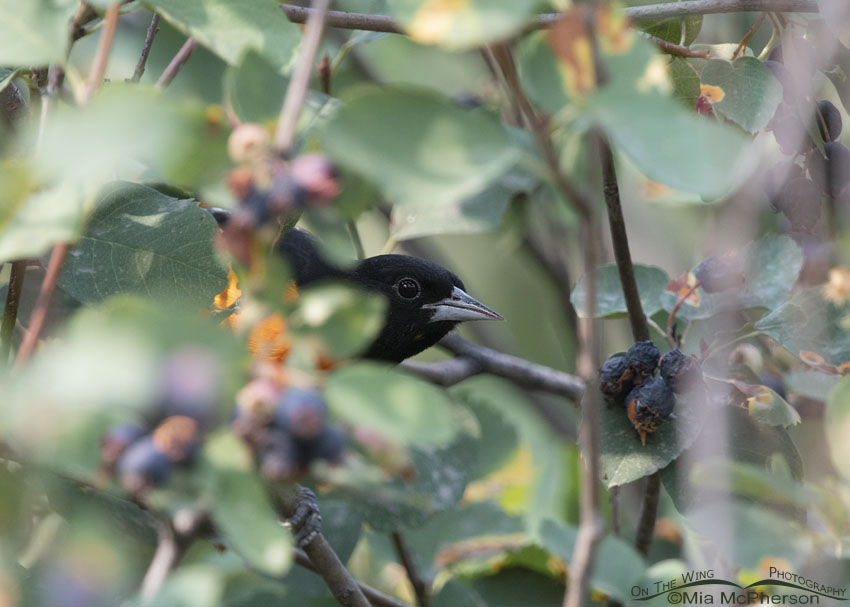 Male Baltimore Oriole hidden in a serviceberry
Male Baltimore Oriole hidden in a serviceberry
So I tried to get more images of it for documentation and identification. For some people my first view of the bird would have been enough but I wanted more so I watched and was able to get this headshot of the Oriole nearly hidden in the leaves.
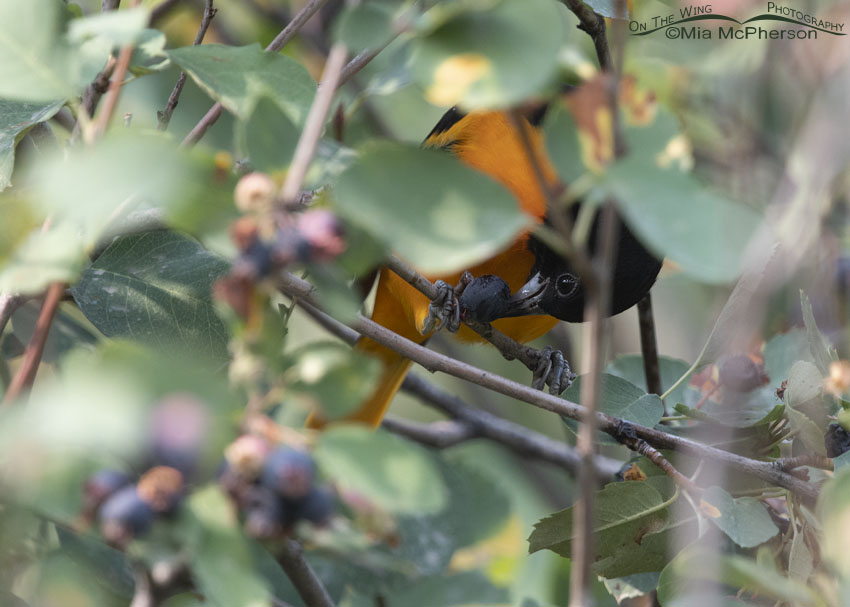 Male Baltimore Oriole eating a ripe Serviceberry berry
Male Baltimore Oriole eating a ripe Serviceberry berry
Then I was able to take photos of the male Baltimore Oriole eating the ripe serviceberry berries. Not great photos but between these three images a positive ID could be made to send my sighting of this rare oriole to the records committee.
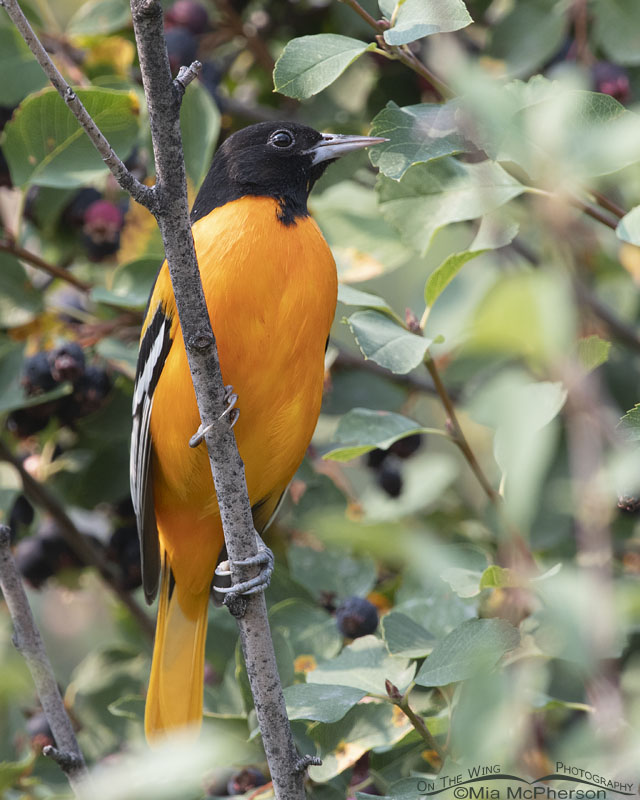 Adult male Baltimore Oriole in a serviceberry
Adult male Baltimore Oriole in a serviceberry
But I wanted a full view of the rare Baltimore Oriole so I waited and waited all the while watching for flashes of orange as it moved through the foliage.
My patience and persistence paid off when the Baltimore Oriole came out into the open. Jackpot! The tip of the oriole’s tail was obstructed by an out of focus leaf but I was delighted to be able to see the entire bird in decent light, photograph him and to admire his beauty.
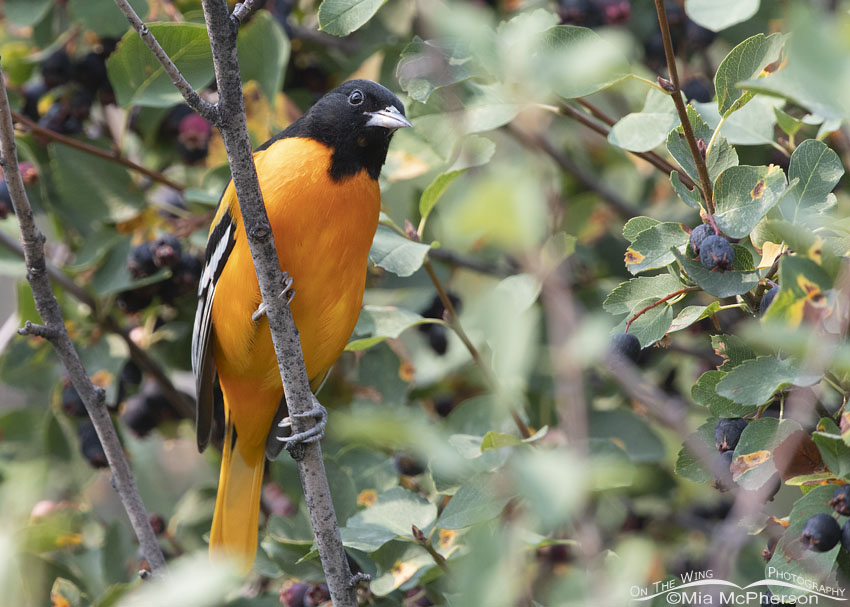 Male Baltimore Oriole in the Wasatch Mountains
Male Baltimore Oriole in the Wasatch Mountains
I took quite a few more photos of the oriole as he looked around as he perched in the serviceberry. He didn’t seem at all concerned by my presence for a brief period of time…
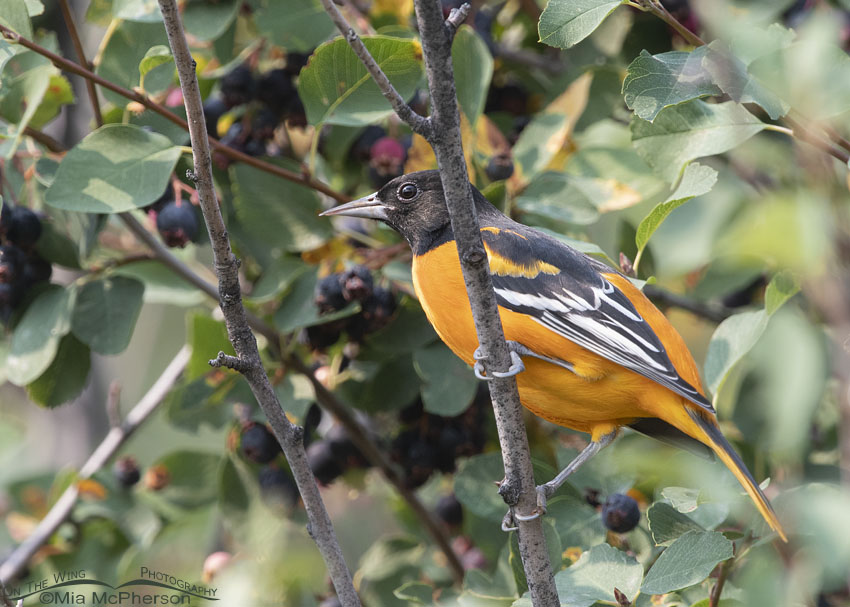 Male Baltimore Oriole in Northern Utah
Male Baltimore Oriole in Northern Utah
And I took advantage of every second I had with him.
A vehicle came up the road and the oriole moved back into the foliage and stayed there so I decided to head home. I didn’t know that Weston Smith, a local Utah birder, was in the minivan that went by or I would have stopped him then and pointed out the rare oriole tucked into the shrub. But after I asked about how rare Baltimore Orioles are in Utah on my Facebook timeline word got out and Weston went back to where I had seen the oriole and he found it too.
I submitted my Baltimore Oriole sighting to the records committee yesterday afternoon and if it is accepted it will be the 7th confirmed sighting of this species in the state of Utah.
I’m glad I waited just that few seconds longer before heading home yesterday or I would have missed finding this Baltimore Oriole.
Life is good.
Mia
I used my Nikon D500, 500mm VR lens with a 1.4x TC attached to take these photos, my aperture was at f7.1, ISO at 800 and my shutter speed varied between 1/400 and 1/500. It was really smoky even in the mountains yesterday and that diffused the sunlight significantly.


Hi honey! It is a beautiful bird! Great photo’s! I grew up in Michigan! I remember seeing them and their hanging nest! Thanks for sharing! love mom
Great shots. I had no idea Orioles drifted so far west. (I guess that’s why it was an unusual sighting.) Your patience paid off big time. Thankfully these Orioles are a lot more fun to watch than their baseball counterparts. Thanks Mia.
Simply beautiful…and good work Mia. I used to have a pair of Bullock’s Orioles coming to the Hummingbird feeder several years ago, but none lately.
Wonderful sighting.
Yay you. And poor Ron.
Ron and I have different driving habits and birding approach while looking for birds so it is very likely I wouldn’t have found the oriole at all yesterday if we had been together instead of me being alone. We did try to relocate it today but dipped on it, we did find lots of other birds to photograph though.
My daughter lives on East Layton bench and she feeds the Orioles but they haven’t been around lately, possibly molting? She isn’t sure this is the same Oriole but the females come often to feast on the grape jelly. What a treat Mia. Exquisite images!
HI Cindy, as discussed in our emails the orioles your daughter sees are Bullock’s Orioles. Thank you.
How exciting, the Orioles are being weird this year. Here in the Arkansas Ozarks I might get to glance one during migration. But this year flocks of them hung around for a couple of weeks. It wasn’t just me but others noted them too. I don’t know if this was just a fluke of if they are change migration patterns due to drought and climate change.
Climate change is always on my mind when I see birds out of their normal range.
So happy you found a rare sighting. Where there is one could be a pair passing thru. We just don’t know. Very pretty.
Thanks Trudy, I will keep and eye out for a pair but this species should be migrating soon and since this one is out of its normal range maybe sooner rather than later.
Cool. Photos Mia
Thanks Bob.
How exciting!!! The “peek-a-boo” pose in the second shot makes me smile.
Marty, I like that peek-a-boo pose too! I call those hidden treasures
Congratulations! What a find. Great photos to boot!
Thank you Liz, I’m glad I waited for it to come out into the open.
Beautiful bird. I’ve never seen one!
Thanks Kim, I hope you see one soon.
Congratulations on the experience and the find! What a special day for you! You got some great photos. I usually have a few dozen at my feeders every year…two years ago 36 large jars of grape jelly were put out for them! Last year one built a nest in my maple tree about 25 feet from the house and the parents wouldn’t let any other orioles go to the feeders on the front porch until the fledglings were out of the nest! I had to move one feeder to the back so the others could get their jelly fix! I never knew how territorial they would be with their young.
Thank you Kathy. 36 jars of jelly! Holey moley! When I lived back east I saw this species during their migration and they were never around for very long. I didn’t know they were that territorial either.
When it comes to sightings of rare wildlife I’m a firm adherent of the “no picture, no bird” school of thought. It’s just way to easy to sincerely believe you’ve seen something when you really haven’t and claim a sighting that isn’t correct. But, when you get a picture, that eliminates the doubt. Congratulations! That is a heckuva sighting and you should be elated.
Steven, I always try to get photos of rarities and try to get decent photos but I have had one sighting that has always bothered me when I spotted a White-tailed Kite in a Florida county where it hadn’t been seen in 98 years, I photographed the bird with the rising sun behind it and those photos were awful, I mean terribly awful, but there was enough in the file to show the key ID features of the bird.
And yes, I am elated!